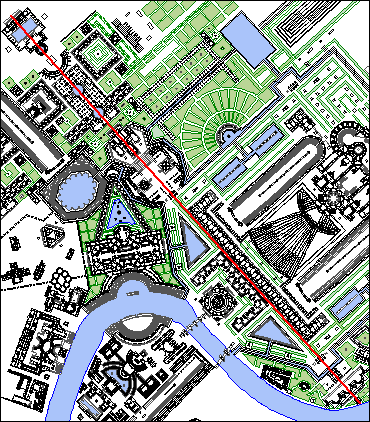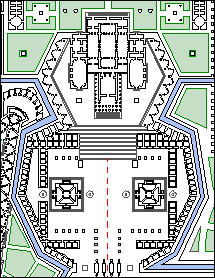| |
1998.07.23
Mars (Martis)
The second temple of Mars, positioned on the west side of the Tiber at the foot of the Vatican Hill, sits within a hexagonal area labeled Apparatorium Triumphatorum -- the place of preparation for the triumphal march. In front of the temple and place of preparation is the decagonal Area Martis, which an euripus (canal/moat) encloses on two sides, and it is here that Piranesi indicates the beginning of the Triumphal Way. Besides the obvious ceremonial importance of the Area Martis, this place is also distinct within the Ichnographia: its ten-sided perimeter is the only such shape throughout the entire large plan. Significant also is the plan of the Templum Martis, whose ichnography resembles male genitalia. The deliberate connection between Mars and overt masculinity is unquestionable. Moreover, the Templum Martis, the Area Martis, and the beginning of the Triumphal Way together establish a principal axis, one of the three major axes present within the Ichnographia. This axis extends from the top of the Vatican Hill straight down to the bank of the Tiber across from the tomb of Augustus, and is not only great in length, but also rich in symbolism. Represented here is the mighty thrust of Mars, the dominance of Romulus, and hence the source of Rome and its unparalleled pride.

| |

The Templum Martis (top) is surrounded by a hexagonal place reserved for the preparation of the triumphal march. The Area Martis (below) is a large space in front of the Templum Martis and the place where the Triumphal Way begins (indicated in red).
The long axis running through the Templum and Area Martis (center) extends from the Nympheum Neronis atop the Vatican Hill (upper left) down to another Nymphaeum on the west bank of the Tiber (lower right).
|
| |
1998.11.16
Tafuri, Manfredo
After an extended independent analysis of the Ichnographia Campus Martius, it becomes evident that Tafuri misreads Piranesi's large plan in most cases. Tafuri's text indicates no research of the plan beyond simply looking at it and subsequently offering a description of what Tafuri thinks he sees. (In fact, a careful reading of both Tafuri's texts and the text of Fasolo from 1956, clearly shows that Fasolo's text greatly influenced Tafuri's observations.) For example, in calling out the various axes of the Campo Marzio, Tafuri notes the axis running through Hadrian's Tomb, but he fails to recognize it's symbolic function as the Axis of Death; nor does he identify the Axis of Life that runs perpendicular to the Axis of Death. Moreover, Tafuri marginally notes the semblance of an axis within the northeast sector of the plan, yet he never mentions that Piranesi labeled this axis the Equiria, place of the annual horse races instituted by Romulus in honor of Mars.
These are just two examples which plainly demonstrate that Piranesi's plan holds significant and coherent symbolic content, however, recognition of Piranesi's "carved in stone" symbolism necessarily negates Tafuri's primary thesis that the Ichnographiam Campi Martii is utterly fragmented and devoid of "language." Ironically, had Tafuri not discounted the presence of language and instead actually translated the hundreds of Latin labels Piranesi applies throughout the plan, he would have concluded with a more accurate, if not also a more honest reading.
It is truly unfortunate that the subsequent 20th century Campo Marzio analyses of Allen, Bloomer, and Eisenman, build upon Tafuri's mistakes rather than correct them.
| |
|